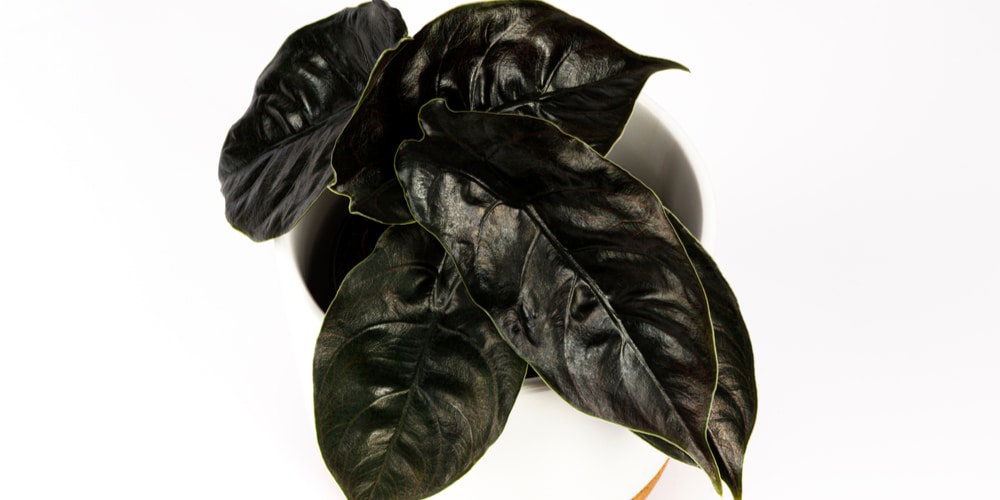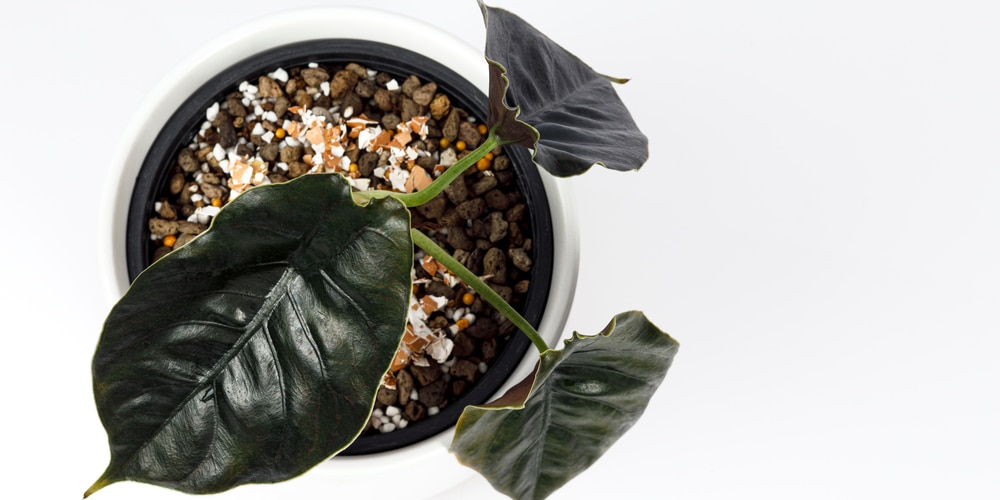Alocasia Azlanii is a unique and rare plant species that is a perfect addition to your indoor plant collection. This plant comes with large, unique, and attractive leaves having a typical Alocasia shape. More so, the metallic sheen, dark green glossy, and slightly wrinkled look make an excellent addition to any apartment. At first glance, these plants may seem hard to care for and many people wonder ‘how to Care for the Alocasia Azlanii plant.’
It’s a strong plant that enhances the indoor look of your home or apartment if you provide the right conditions. Nevertheless, most individuals and homeowners find it challenging to grow and cultivate the plant appropriately. If you’re looking for a guideline for cultivating the Alocasia Azlanii, you’re in the right place. This article provides a comprehensive guide on how to care for the Alocasia Azlanii plant.
How to Care for the Alocasia Azlanii
ALOCASIA AZLANII IS A TROPICAL PLANT THAT PREFERS A WELL-DRAINING SOIL MIX, BRIGHT & INDIRECT SUNLIGHT, AND REQUIRES MODERATE WATER TO THRIVE. WHEN THE TOP 2 INCHES OF YOUR SOIL APPEAR DRY, YOU CAN WATER IT TO PREVENT WATERLOGGED SOIL. IN ADDITION, THE PLANT FEELS MORE COMFORTABLE AND THRIVES WELL UNDER HIGHER HUMIDITY, AT LEAST 60%, AND IN TEMPERATURES RANGING BETWEEN 65 AND 75F (18 TO 24 DEGREES).
Sunlight
Being a tropical plant, it thrives well in bright & indirect light. Nevertheless, Alocasia Azlanii can tolerate a few hours of direct morning sunlight despite thriving well under indirect sunlight. Exposing your plant to too much sunlight may cause damage or a burning effect on the leaves, which hinders the growth of this plant.
Alternatively, while growing the plant inside the house or apartment, the Alocasia Azlanii can thrive well under growing lights. You can comfortably grow these plants under artificial lights to enhance their growth under the appropriate sunlight conditions. When growing them under artificial lights, you can use a LED having a full daylight spectrum. Importantly, position this spectrum about 30cm or a foot away from it for approximately 14 hours daily.
Watering
While growing this plant, it’s imperative to understand that it thrives well in damp soil. Importantly, ensure that the soil is damp, not soaked, or waterlogged. You can confirm this by checking the soil water levels at least twice weekly. When checking the soil, ensure that you manage the water level it receives to prevent waterlogged soil.
Additionally, the best time to water your plant is when the top 5 cm or 2 inches of the soil seems dry. As you water the plant, ensure you use a growing pot with numerous drainage holes. The holes will play a vital role in releasing excess water to prevent waterlogging in the planter’s bottom, making the roots rot.
Experts advise that you provide sufficient water for your plants to avoid the adverse effects of under watering or overwatering the plant. If you overwater it, the roots become soaked in water and begin to rot, while under watering results in the leaves turning yellow and drooping. Importantly, this plant will require less water during the winter due to the plant’s dormancy.
We’ve got various techniques you can use to determine the amount of water the plant requires. For instance, when you realize brown or black spots on the leaves, provide less water. Alternatively, you can use a moisture probe to indicate the amount of moisture in the soil. When the probe gets to 2 on the Alocasia Azlanii’s growing pot, then it’s necessary to water your plant.
Pruning
You’re also required to prune the Alocasia Azlanii plant like other interior plants. Pruning helps to ensure the plant isn’t bushy, remains attractive, and offers the appropriate interior design. When pruning the plant, you’ve to cut off or prune large edges of their elephant ear, especially when the occasional cold snap hits the leaves. Experts advise using clean, sharp, and sterilized pruning shears or scissors when pruning to reduce damage to the plant.
Humidity
The plant grows well in high humidity, approximately humidity of 60% and above. The humidity is the proper humidity that matches its origin’s higher humidity climate. Growing Alocasia Azlanii in lower humidity levels results in stunted growth or may cause more stress on the plant, resulting in poor or irregular growth patterns.
Growing the plant in low-humidity levels results in brown leaf edges and spots. Significantly, if you’re in a region with low humidity levels, you can increase the humidity levels using an automatic spray or mister. You can spray the leaves with a water-filled spray bottle two or three times.
How to Care for the Alocasia Azlanii in different USDA Climate Zones
The performance and thriving of this crop will depend on the amount of water or rainfall, summer highs, winter lows, humidity, and other factors. Alocasia Azlanii, a tropical and hardy plant, thrives well in USDA growth zones ranging from 3 to 11. These zones have average winter temperatures, higher humidity, and rainfall that help the plant grow and thrive. These are the appropriate conditions for growing and cultivating the plant successfully.
Fertilizer
The best way to replenish essential nutrients in the soil is to provide the appropriate fertilizers. Experts advise that you give the Alocasia Azlanii fertilizers at least once monthly in the summer and spring. Unlike the other seasons, the plant requires more nutrients to grow and thrive well during these seasons.
While fertilizing the plant, it’s essential to avoid using too much fertilizer, as it may cause burns to the plant. The appropriate amount of fertilizer to use for your plant is diluted balanced one. For instance, when the manufacturers instruct you to use one tablespoon of the fertilizer per water gallon, experts advise that you use of the spoon instead. Additionally, it’ll be good to apply twice a month to achieve the best results and avoid burning the plant.
Soil Type
The appropriate soil type for growing this plant is an aerated and well-drained potting soil with some water retaining abilities. You can use coconut husk and perlite potting mix to achieve the appropriate composition when making the potting soil. This composition will be essential to provide the plant’s roots with the proper oxygen to keep it healthy.
Furthermore, when considering the soil type, it’s imperative to understand the plant doesn’t thrive well in soaked soil. Thus, to prevent wet soil that hinders the oxygen level to the plant’s roots, it’s good to avoid watering completely damp soil. It’ll be good to check if the soil mix you’re using is suitable for your plant. If the topsoil doesn’t dry in one week, then you’re using too heavy soil.
Propagation
The Alocasia Azlanii is one of the less-costly indoor plants due to the various methods you can use to propagate them and have more plants. You can reproduce the plant by using seeds, divisions, or offsets.
Regardless of the propagation method you choose, ensure that you propagate them during the summer and spring (growing seasons), not during their dormant period. You’ll enhance the chances of cultivating them successfully and realize the changes quickly during the growing seasons. Below are the different propagation methods:
Offsets
Offsets are a popular way of cultivating Azlanii, as they’re straightforward and less costly to propagate. Using offsets involves using an existing miniature plant version having a healthy bearing to start growing. Despite the easy cultivation technique, you’ll need to be very careful when propagating them to avoid smaller or younger plants less than 3 inches or 7.5cm, as they won’t be ready for propagation.
When using this propagation method, remove the plant’s offset from the primary plant. It’ll be essential to remove the plant carefully to prevent causing any damage to its roots. It’d help if you use pruning shears to remove the offsets appropriately. Experts advise you to cut the roots directly attached to a healthy mother plant when using the shears. After cutting it, carefully plant it in the appropriate pots, proportional to the offset’s size to prevent the plant from drowning in water.
Seeds
The Alocasia Azlanii seeds offer the best and most cost-effective way to propagate your plant. Regardless of the season, using seeds is the best way to enhance growth results. Nevertheless, it’s the slowest and most frustrating method of propagation that requires a lot of care and patience as the plant grows.
Below are the essential steps you need to follow while propagating the crop with seeds:
i. Soak the plant’s seeds in water, preferably distilled for one night
ii. Then sow them in the soil, approximately 1.5 cm or 0.5 inches deep
iii. After sowing the seeds, water them lightly, providing sufficient humidity level for some weeks
iv. After two months following the germination, transplant the seedlings into a larger port
Division
The division method offers the most effortless propagation mechanism for reproducing your crop, which involves simple steps. You can achieve division propagation by cutting the plant’s rhizomes (plant’s thick stem) using a sharp knife into two or several pieces.
When cutting the plant, ensure that the parts have at least one eye, which refers to an indentation where the plant’s new shoot sprouts. After getting the right parts for division propagation, you can either water them and put them in the proper soil type or replant them to get all the nutrients and thrive.
How to Care for the Alocasia Azlanii: Conclusion
Alocasia Azlanii is an excellent addition to your house’s interior due to its unique and attractive leaves. However, to achieve a healthy and beautiful plant, it’ll be imperative to provide it with the appropriate conditions and take good care of the plant.
Providing the plant with moderate water, higher humidity of above 60, providing a balanced fertilizer, providing indirect sunlight, and pruning it when bushy are the best mechanisms to care for the plant.
You May Also Like: 11 of the Most Expensive Plants in the World


